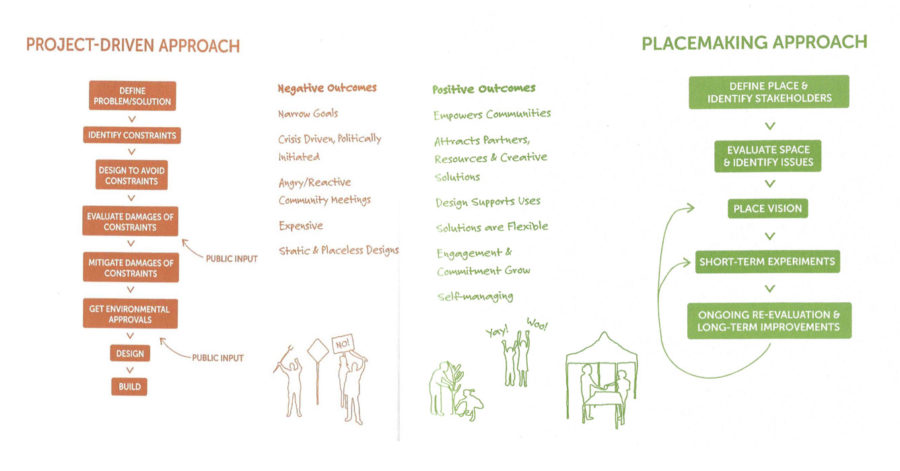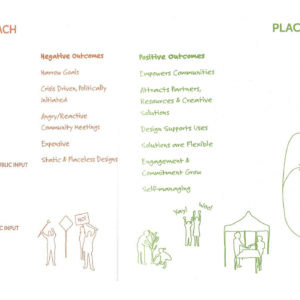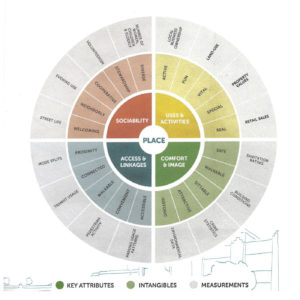Activities
What is Placemaking?
Author: Faye Sciberras, February 2022
Placemaking is the creation of public spaces which connect people to spaces. It is a process centered around people and their needs, aspirations and visions for a particular space or for the town or village they live in[1]. One can thus simply define Placemaking as a process to create quality places that people want to live, work, play and learn in[2].
In order to achieve Placemaking, there is an approach which is both a philosophy as well as a practical process for the transformation of a public space into a place. The philosophy focuses on common and shared values amongst the different stakeholders aiming at providing a better environment for the people. Its aim is to increase place attachment and create places that reflect the local identities of the people to transform them into active players and local guardians[3]. Project for Public Spaces studied more than 3,000 public spaces around the world and found that, in order for a place to be successful, one needs to have four key qualities. Great and successful places need to be sociable, have a variety of uses and activities, are well-connected to their surroundings and are comfortable and welcoming[4].
This should be the goal of every urban space if it is to be a place. When looking at some of the public spaces in the local community, it is possible to observe which spaces have been transformed into successful places and which fall short. Those which fall short are usually the ones where a design was created but not a designed place. In these cases, the final outcome does not address the needs of the end users/community. For this reason, these spaces end up soulless and void from human interaction which in turn leads to the creation of unsafe and dilapidated areas.
Project for Public Spaces uses a five-step process when implementing the Placemaking approach in which the community is involved from the very beginning, to get people to observe and contribute towards shaping a space into a place. With this approach the community who have a direct interest in the space plays an important role in the success of the project. Ownership is created towards the place which in turn will lead to a strong interest in its implementation and upkeep[5].
It should be kept in mind that we are an ever-evolving community, and so, the urban fabric needs to grow and evolve with the community it houses. Thus, in truth, a project is never truly finished. For a place to remain relevant and used, its relevance needs to be reevaluated and there need to be long-term improvements and maintenance plans to implement as required. What might start off as an interactive garden for children, could remain relevant throughout time or might slowly evolve into a community garden as the residents around the space change, grow and age.
Placemaking can be used for small community projects as well as large-scale projects. In his article Four Types of Placemaking, Robert Steuteville[6] explains three types of specialized Placemaking approaches. These types of specialized approaches are used for large-scale projects which need to attract specific groups of people from different localities to a place created for a particular activity/use.
Ultimately, all forms of Placemaking boil down to the same intrinsic philosophy and approach. The success of the Placemaking approach depends on the broad engagement of stakeholders during the design process so as to ensure that a project addresses the needs and requirements of the people who will ultimately use the space and thus form an attachment towards the place.
[1] Moriera, S. (2021) What is Placemaking? Archdaily. Retrieved December 2021, from https://www.archdaily.com/961333/what-is-placemaking
[2] Steuteville, R. (2014) Four types of placemaking. Public Square, A CNU Journal. Retrieved December 2021,https://www.cnu.org/publicsquare/four-types-placemaking
[3] Keleg, M.M. (2020) Prospects of Placemaking Progression in Arab Cities. The Journal of Public Space, Vol 5 No 1. Retrieved January 2022, from https://www.researchgate.net/publication/340450381_Prospects_of_Placemaking_Progression_in_Arab_cities
[4] Madden, K (2021 )How to Turn a Place Around: A Placemaking Handbook. Project for Public Spaces, Inc.
[5] PPS (2017) The Placemaking Process. Project for Public Spaces Inc., Retrieved December 2021, from https://www.pps.org/article/5-steps-to-making-places
[6] Steuteville, R. (2014) Four types of placemaking. Public Square, A CNU Journal. Retrieved December 2021,https://www.cnu.org/publicsquare/four-types-placemaking


